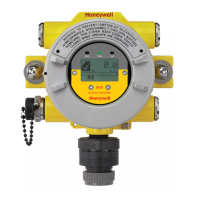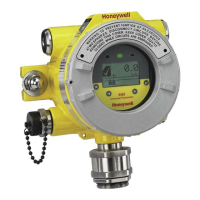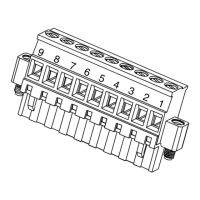XNX Universal Transmitter Quick Start Guide
50
suddenincreaseinambienthumiditycanresultinashort-termpositivedriftinthe
instrument’sreading.Asuddendecreaseinambienthumiditycanresultinashort-
termnegativedriftintheinstrument’sreading.Thesearemostlikelytobenoticed
duringcalibrationwithdryorcylindergas.
When calibrating Hydrogen Sulfide cartridges the following should be taken into
account while following the procedure in Section 8.1.1:
1. Tozerothesensor,useacompressedgascylinderof20.9%Vol
oxygen(notNitrogen).Donotusebackgroundair.
2. Ifaspancalibrationistobeperformed,thespancalibrationgasshould
beappliedtothesensorimmediatelyafterthezeroingprocedure.Donot
allowthesensortoreturntoambientairconditions.
8.1.4 XNX EC Sensor Operational Life
Typical life of a toxic gas sensor is dependent on the application, frequency
and amount of gas exposure. Under normal conditions, with a 3 month visual
inspection and 6 month test/re-calibration, the toxic sensor has an expected life
equal to or greater than the lifetime as listed below:
• 12monthsforAmmoniaandHydrogenFluoridesensors.(SeeAmmonia
notebelow.)
• 24monthsforChlorineDioxide,Oxygen,andothertoxicsensors.
CAUTION
Oxygen decient atmospheres (less than 6%V/V) may result in inaccuracy of reading and
performance.
NOTE:
Ammonia electrochemical cells are reliable and suitable for applications where
no background concentration of ammonia exists. Under these conditions the
cells are expected to operate for 12 to 24 months.
These ammonia cells are of the consumptive type. Their operating life can be
adversely aected by continuous or excessive exposure to ammonia, or by
prolonged exposure to high temperatures and moisture.
To ensure continued detection availability, it is recommended that the detectors
are regularly bump tested and a relevant cell replacement program be
implemented.
8.1.5
Zero and Span Calibration for MPD Sensors
CAUTION
Extended or frequent exposure to elevated concentrations of combustible gases
may aect sensor sensitivity. Verify sensor performance by frequent calibration.
CAUTION
Before initial calibration, allow the detector to stabilize for 30 minutes after applying power. When
in zero and span calibration mode, the current output from the detector is inhibited (default 3mA) to
avoid false alarms.

